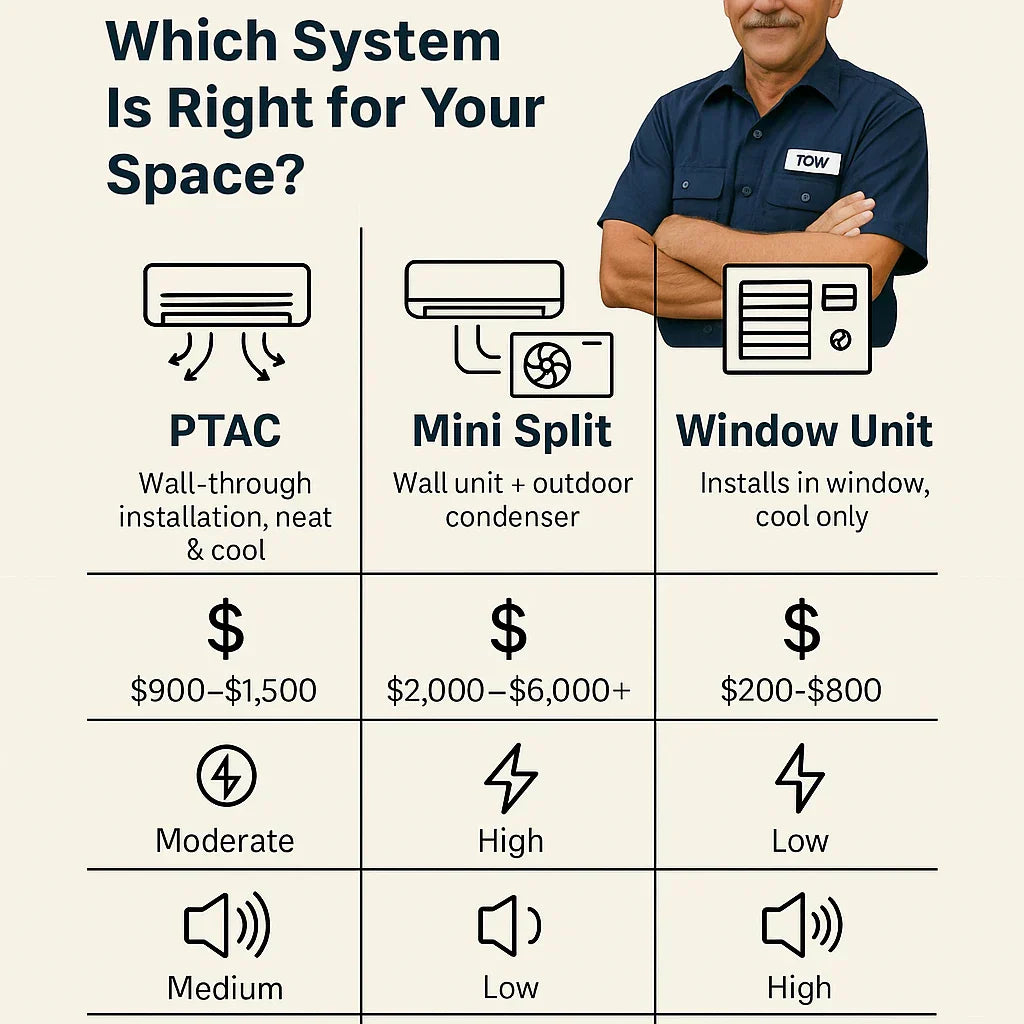When Tony needed to replace the old AC in his home office, he faced three options: a PTAC unit, a ductless mini split, or a window AC. Each promised comfort, but the differences in cost, efficiency, installation, and long-term performance weren’t obvious at first.
Amana Distinctions Model 12,000 BTU PTAC Heat Pump with 3.5 kW Electric Heat Backup
If you’re in the same spot—trying to figure out which system works best for your room or apartment—this guide breaks it all down. With Tony’s real-world experience and expert references, you’ll know exactly which system fits your space and budget.
🔍 What Are the Main Differences?
🟦 PTAC (Packaged Terminal Air Conditioner)
-
Design: Installed through the wall with a wall sleeve, self-contained unit.
-
Functions: Cooling + heating (heat pump or electric resistance).
-
Best For: Apartments, hotel-style suites, or rooms where permanent installation makes sense.
-
Key Feature: Year-round operation in one system.
🟧 Mini Split (Ductless System)
-
Design: Indoor air handler(s) connected to an outdoor condenser with a refrigerant line set.
-
Functions: Cooling + heating, with zoning flexibility.
-
Best For: Whole homes or multi-room layouts.
-
Key Feature: Highest efficiency (SEER2 up to 25+).
🟩 Window Unit
-
Design: Compact AC mounted directly in a window frame.
-
Functions: Cooling-only (some include heat strips).
-
Best For: Small spaces or temporary setups.
-
Key Feature: Lowest upfront cost and DIY-friendly.
💰 Cost Comparison: Upfront & Long-Term
Tony’s first concern? Cost. Not just the purchase price, but also the long-term utility bills.
| System Type | Upfront Cost | Installation | Lifespan | Long-Term Costs |
|---|---|---|---|---|
| Window Unit | $200–$600 | DIY | 5–7 years | Higher energy use |
| PTAC | $900–$1,500 | Pro or skilled DIY | 7–10 years | Moderate bills |
| Mini Split | $2,000–$6,000+ | Pro (DIY possible with MRCOOL kits) | 12–20 years | Lowest bills |
👉 Tony’s Tip: “Don’t just look at sticker price. Think about how many summers—and winters—you want out of the system, plus the utility bills in between.”
External Resource: U.S. Department of Energy – Heating & Cooling Costs.
⚡ Energy Efficiency
PTAC Units
-
Typically rated by EER (Energy Efficiency Ratio).
-
Average: 9–11 EER.
-
Meets basic ENERGY STAR standards for efficiency.
Mini Splits
-
Rated by SEER2 (cooling) and HSPF2 (heating).
-
Average: 18–25 SEER2 → top efficiency in residential HVAC.
-
Savings: Up to 30–50% lower energy use compared to PTACs and window units.
Window Units
-
Typically 8–10 EER.
-
Lowest efficiency, often not ENERGY STAR certified.
👉 Reference: Energy.gov – Energy Saver: Room ACs.
🔊 Noise Levels
Noise was a huge factor for Tony since his office doubles as a quiet workspace.
-
Window Units: Loudest. 55–60 dB (like office chatter).
-
PTACs: Moderate. 45–55 dB depending on fan speed.
-
Mini Splits: Quietest. As low as 25 dB (like a whisper).
🛠️ Installation & Space Needs
🟦 PTAC
-
Requires wall sleeve (42” x 16”).
-
Needs 230/208V wiring.
-
More permanent installation—often better for owners than renters.
🟧 Mini Split
-
Indoor + outdoor components.
-
Needs a line set drilled through the wall.
-
Best installed by a pro, but DIY kits (like MRCOOL) are changing the game.
🟩 Window Unit
-
Plug-and-play installation in a window.
-
No special wiring needed.
-
Blocks part of your window light and view.
👉 Reference: Amana PTAC Official Installation Guides.
🌎 Best Use Cases
Window Unit
-
Small bedrooms, rental apartments, dorms.
-
Short-term or budget cooling.
PTAC
-
Guest apartments, hotel-style rooms, office spaces.
-
When you need both heating & cooling in one permanent system.
Mini Split
-
Whole homes, multi-zone spaces, open layouts.
-
Best for long-term investment in efficiency.
👉 Check Energy Vanguard’s AC sizing guide for proper system sizing.
💡 Tony’s Case Study
Tony tested all three systems in real spaces:
-
Window Unit (Old Bedroom AC): Cheap and quick, but noisy and struggled on hot days.
-
PTAC (Amana Distinctions 12k BTU): Perfect for his 500 sq. ft. guest apartment—quiet enough, reliable, and had backup heating.
-
Mini Split (Living Room): Higher upfront cost, but ultra-efficient, quiet, and made the whole living area comfortable year-round.
His verdict:
“For one room that needs year-round comfort, I’d go PTAC. If I was redoing the whole house, I’d invest in a mini split. Window ACs? Good for short-term or rentals, but not long-term.”
🧮 Pros & Cons Table
| Feature | PTAC | Mini Split | Window Unit |
|---|---|---|---|
| Cost | $$ | $$$$ | $ |
| Efficiency | Moderate | High | Low |
| Noise | Moderate | Quiet | Loud |
| Heating | Yes (heat pump + backup) | Yes | Limited |
| Installation | Wall sleeve + wiring | Indoor/outdoor + pro install | DIY |
| Best For | Apartments, hotels, medium spaces | Whole-home, multi-zone, premium comfort | Rentals, short-term use |
🎯 Final Verdict: Which One Should You Choose?
-
Choose a Window Unit if you’re on a tight budget, need quick cooling, or live in a rental.
-
Choose a PTAC if you want reliable year-round heating and cooling in a medium-sized space.
-
Choose a Mini Split if you can invest more upfront for the best efficiency, quietness, and long-term comfort.
Tony’s advice:
“Think about where you’ll be five years from now. A window unit is a band-aid, a PTAC is a solid solution, and a mini split is a future-proof investment.”
In the next topic we will know more about: Installation Guide: Can You DIY a PTAC or Should You Hire a Pro?







